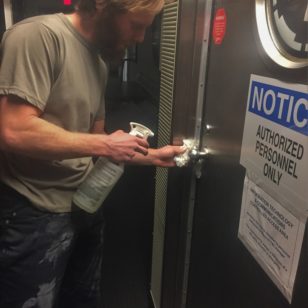
It takes a lot of hands to keep the South Pole Station Clean. Every Tuesday, the entire winter over crew rallies to clean every square inch of the facility. (Photo: C. Krueger)
You’d be surprised how much mess 50 people in a large research station can create. Here at the South Pole, where it takes six months for the sun to rise, it only takes two days for a 30 gallon (113 liter) trashcan in the bathroom to be stuffed to the brim and overflowing with used paper towels. Hallway floors turn from bright white to off white in a little less than a week. Dust accumulates, in every corner, on every surface—the collective residue of the station residents’ epidermis, aggravated by dry air, frigid temperatures, and lackluster use of moisturizing lotions.
Fortunately, there is a rigorous system in place for preventing the station from falling into total decay. Where you are from, it might be called Sunday morning cleaning. If you are young and living in a group home, it’s the chore wheel taped to the refrigerator. If you are working for the National Science Foundation in Antarctica, it’s called House Mouse, and takes place every Tuesday from 4 to 5 in the afternoon.

A focused House Mouser sterilizes each of the station’s 100 door knobs–one of many tasks that take place weekly. (Photo: R. Klein)
I am not sure how an hour of mandatory community cleaning came to be called “House Mouse.” I am no etymologist, but I do have a few pet theories—I’ll share one of them with you.
If there is one thing all grown men detest, it’s having to clean the departed follicles and urinary inaccuracies from the rim of a well-used, public, 1.5gpf white porcelain toilet. It is a brutal experience that comes with a brutal stigma that not even soaking in bleach can remove. “House Mouse” trivializes the experience of cleaning out the urinal, or pulling wads of hair out of the shower drain. The phrase rhymes, and stirs up images of anthropomorphized rodents and Disney classics. It makes the dirtiest tasks feel cute, and when you are hanging out with your friends at dinner, and one of them asks what you did that afternoon, you can say “House Mouse” and everyone smiles, still willing to shake your hand, and accept the bottle of hot sauce you passed down the table.
During House Mouse, the entire station breaks from their usual tasks, and picks up a broom or mop or some all-purpose cleaner. From the right vantage point, the hour appears to unfurl like the “Off to Work” scene in Snow White and the Seven Dwarves, with stout men, complete with full beards, popping out of the subfloor, marching up ladder wells and throwing open office doors, keenly focused on the task ahead, and moving with determination towards the nearest cleaning locker.
VIDEO: House Mouse mopping
Often, we work in teams of four, typically divided by work center, to accomplish the particular duty we have been assigned that week. To my advantage, my team includes two previous winter-overs, who – between their multiple decades on ice – have developed effective strategies for tackling even the most unsavory “House Mouse” duties. Needless to say, I expect to learn much under their tutelage.
VIDEO: The most efficient way to mop a treadmill
Last week, my team was assigned one of the better chores on station—working with the Winter Site Manager to replace old, worn-out furniture in our lounges with new furniture that had arrived before the station closed. The work was physically demanding, as we had to haul couches, love seats and chairs up multiple flights of stairs, and down long hallways, but it was rewarding– the type of task that makes it okay to have two slices of chocolate cake with butter-pecan ice cream and sprinkles at dinner.
Over the next several months, every team will rotate through each House Mouse activity, meaning sooner or later, I’ll end up on bathroom duty. It’s still a few weeks out. Next week is tidying up the Arts and Crafts Room, and the week after that will be shoveling snow from the station’s main entrance and emergency exits. I’m not looking forward to my expedition into the toilet stalls, but as more than one South Pole veteran has told me, “it’s a harsh continent.”























Comments are closed.